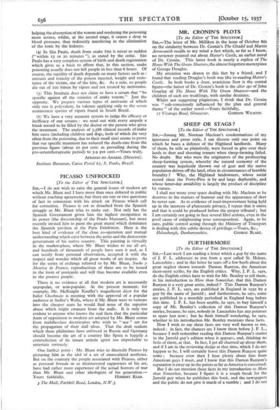SCIENCE AND THE SNAKE
[To the Editor of THE SPECTATOR.]
should like to make a brief reply to the criticism offered in the August 2oth issue of your journal to Dr. Sherwood Taylor's original article about "Science and the Snake."
(r) Conditions found in Goyaz and other central States of Brazil are certainly not comparable with those encountered in Sao Paulo and other southern States.
(2) The Instituto Butantan received, from 1910 to 1936, 338,331 alive specimens of serpents mostly from the farming district of our hinterland. In this total 78,388 specimens were non-poisonous ; therefore, the proportion of only i in every to specimens being dangerous, as published by the critic, is not correct. Our correct figure is more than seven times as high as that : 73 poisonous specimens are found in every too snakes. Needless to say, that every specimen in that total was scientifically identified by our assistants at this Institute.
(3) Had the critic ever been bitten by a viper and suffered the effects of a severe poisoning, I feel that he would not" have trusted to the excision of the wound, with application of per- manganate of potash and liberal drinks of brandy." Other- wise, he will have died and not have been able to write that topic. Indeed, excision of the wound, which in most cases of snake bite amounts to amputation, does not cure the poisoning, due to the quick absorption of the venom constituents by the blood ; potassium permanganate in strong concentration may in vitro neutralise some poison, but in vivo it is just as poisonous as snake venoms in general, whilst in weak concentration it is not effective at all ; liberal drinks of brandy or of any alcoholic beverage, at the first stage, cause a rise in blood pressure, thus helping the absorption of the venom and rendering the poisoning more severe, whilst, at the second stage, it causes a drop in blood pressure, thus indirectly interfering in the elimination of the toxic by the kidneys.
(4) In So Paulo, death from snake bite is never so sudden (" within 15 or 20 minutes "), as stated by the critic. Sao Paulo has a very complete system of birth and death registration which gives us a basis to affirm that, in this section, snake poisoning usually does not kill people in less than 6 hours. Of course, the rapidity of death depends on many factors such as : amount and toxicity of the poison injected, weight and resis- tance of the victim, site of the bite, &c. As a rule, 20 people die out of too bitten by vipers and not treated by antivenins.
(5) This Institute does not claim to have a serum that "be specific against all the varieties of snake venom." Just the opposite. We prepare various types of antivenin of which only one is polyvalent, its valence applying only to the seven commonest species of vipers found in South Brazil.
(6) We have a very accurate system to judge the efficacy or inefficacy of our serums : we send out with every ampule a blank record to be filled by the doctor or the person who gives the treatment. The analysis of 5,586 clinical records of snake bite cases (including children and dogs, both of which die very often from the poisoning, due to their small size) seems to prove that our specific treatment has reduced the death-rate from the previous figure (about 20 per cent, as prevailing during the pre-serumtherapeutic period) to 3.9 per cent.—Yours truly,























































 Previous page
Previous page